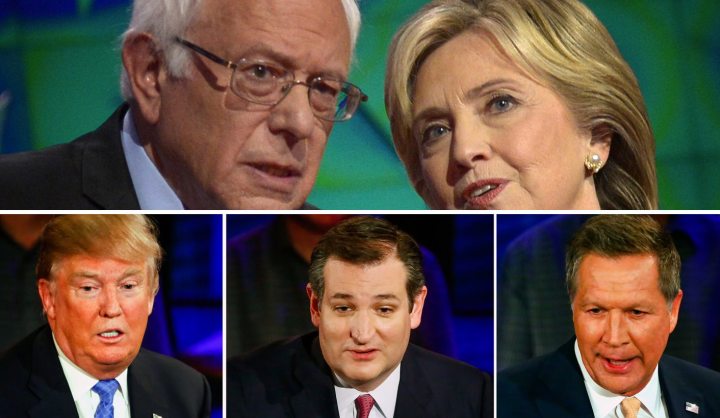World
US 2016: Candidates hang on to the roller-coaster

Taking a brief respite from South Africa’s slow-motion constitutional crisis, as well as retrospective glances towards Richard Nixon’s agonies as potential auguries for what could happen in South Africa, J. BROOKS SPECTOR catches up on the US presidential campaign.
This year’s American presidential selection has already had about as many unexpected twists and turns as a prize-winning amusement park roller-coaster ride, and there is still so much fun left to enjoy. First, of course, has been the implosion and disappearance of the financially extremely well supported, lamentable candidacy of Jeb Bush.
Positioned as a largely centrist Republican, at a time when a major section of his party’s base was in an increasingly foul, anti-establishment mood, Bush’s effort eventually sank out of sight under the weight of being a politician of reason and continuity (and the latest scion of a long-time political family), when his would-be supporters went looking, instead, for someone who would shake things up and turn them inside out – to fix all the things that were “broken” with America. As a result, the inevitability of Jeb Bush as his party’s natural centrist winner – let alone as a viable candidate at all – has ceased to be a topic of conversation.
Similarly with Marco Rubio, the freshman senator from Florida who tried to offer a message of a Republican-style, semi-establishment optimism towards the future, echoing the psychological positioning of Barack Obama in 2008 and even John Kennedy back in 1960. Unable to make a coherent case for this candidacy, when last spotted by a sharp-eyed member of the media horde, Rubio was travelling alone from Washington to Florida in seat 19 C of a commercial jet, sans aides, reporters or any other hangers-on.
Once all the other no-hopers and never-had-a-chancers were washed away, the nativist-populist-property-developer-casino-builder-reality-TV- showman-serial-polygamist-and-policy-naïf Donald Trump was left standing, working overtime to put away both Texas Senator Ted Cruz (the hard-right, Tea Party-esque and most disliked member of the US Senate) and the good, grey, Ohio Governor (“I want to be the adult in the room”), John Kasich. That task accomplished, Trump could claim the Republican Party’s presidential nomination. Mind you, this is the same party that once gave the country people like Abraham Lincoln, Theodore Roosevelt, and Ike Eisenhower as presidents (as well as a few less savoury types such as Richard Nixon and George W Bush).
In a string of recent primaries, Trump seemed to be moving inexorably forward to that implausible goal, despite increasing murmurs of disapproval from the party’s remnant centrists, social conservatives and old-style, main street small government supporters – and most especially the party’s crop of current office-holders. The latter were becoming increasingly worried a real Trump candidacy at the head of the party’s ticket might wipe many of them out as office-holders, once all citizens entered their various voting booths and thought carefully about who was going to be holding the nuclear missile launch codes.
Those frequent videos of raucous, angry Trump rallies, his increasingly shrill rhetoric and wild forays into attacks on pretty much every ethnic group, race and sex, save for older white men without college educations and shrinking job opportunities, was increasingly wearing thin with many others. A few days ago, Trump was engaged in The Washington Post in a wide-ranging interview that helped lay bare his virtual incoherence on even some of his own publicly stated policies. While this interview, even though widely reported, probably had little direct effect on his support, in the most recent primary state of Wisconsin on 5 April, the voters gave him a serious smackdown, voting overwhelmingly for Ted Cruz instead.
In fact, so far at least, Trump has not yet actually won a majority of Republican supporters in any primary contest. Would-be mathematicians may wish to ponder the facts that his support has generally been around 35-40 percent of those voting in Republican primaries – and his support levels among women seem to be staying at historic lows in American politics. Moreover, voting percentages in primaries are just a fraction of the potential electorate and those who say they are Republicans represent about 30 percent-plus of the eligible electorate.
Work the numbers through and it fairly seems to shout that Trump’s real support stands at below 20 percent of the actual national electorate – and that’s not generally a winning percentage. None of that foretells great success in a general election, come 8 November. Now, add in his disapproval ratings and his “will not vote for” numbers, and one gets a sense of the nature of incipient panic among Republican office-holders.
And so this is where a sudden burst of interest in Republican Speaker of the House (Wisconsin congressman and former vice-presidential candidate in 2012) Paul Ryan comes from, even if Ryan is hardly beating the drum for such a candidacy. Still, Ryan has the kind of political savvy and experience the GOP establishment seems to crave, he’s not really in the bad graces of either social or economic conservatives, and he has not, so far, managed to annoy the kinds of people who have become Trump’s core support.
Taken together, this is helping feed a bubble of talk pushing the idea of a brokered or open convention for the Republicans. If Donald Trump fails to claim 1,237 pledged delegates from all the primaries and caucuses by the time the convention comes around on 21 July in Cleveland, and thereby does not get to claim the nomination on the first ballot, the rules for many state delegations would end up releasing those delegates from support for Trump for any subsequent votes.
That could open up the convention for a floor fight over a name newly put into nomination and thereby allow for someone other than Trump, Cruz or Kasich to emerge as the chosen one by 25 July. This would be the first time in several generations since such a thing happened, but, technically, nothing would stand in its way besides a public uproar by the Trump battalions.
Of course, Trump may astound people yet again and trounce his opponents in the New York primary on 19 April, and then do nearly as well in several other north-eastern states and then even in California once that primary comes round. If that should happen, a Paul Ryan candidacy goes back in the box for another time, and Kasich and Cruz both will have to drink some metaphorical political hemlock, at least for 2016.
Among Democrats, in the wake of his win in the Wisconsin primary, and according to his supporters at least, the momentum seems to have swung decisively towards Vermont Social Democratic Senator Bernie Sanders in his unlikely bid for the party’s nomination. However, and here’s the big point, the maths is still running strongly towards Hillary Rodham Clinton, sufficiently so that it would require Herculean efforts by Sanders’ campaign, and a 60+ percent delegate haul in every remaining primary, to surpass Clinton’s current trajectory towards a win.
According to the numbers, Clinton now has about 1,279 selected delegates and 469 super-delegates (largely selected by virtue of their being incumbent office holders and “informally” pledged to her), in comparison to 1,027 and 31 respectively for Sanders. The nominee must gain 2,383 delegates to win the nomination for the Democrats. Unlike many of the remaining Republican primaries, Democratic primaries are not winner-takes-all contests. As a result, even if a candidate loses the overall vote, they will still gain a proportionate share of the delegates at stake. Clinton only needs to gain about 635 more delegates for the whole thing to be over with her in the winning position.
In that sense, Sanders is no longer really running for the nomination. But, by virtue of the enthusiasm he has stirred up for his campaign and his issues, instead he is campaigning for the soul of the Democrats in order to give Clinton a sharp shove in the direction of the leftward edge of Democratic Party orthodoxy. Unlike Trump’s eclectic, grab-bag of positions and his inchoate rage against the machine, the Sanders campaign is largely a resurrection of a litany of older Democratic ideals with regards to economic equality and fairness. These have their ultimate origins in positions that go right back to the 1932 election that gave Franklin Roosevelt the first of his four electoral victories in the midst of the Great Depression.
Like Trump, Sanders also had a particularly unsatisfactory encounter with the media in an interview with The New York Daily News that managed to expose just how little he has really thought through the actual nuts and bolts – or even the legislative roadblocks – for his core rallying cries, such as that seemingly popular “break up the big banks” mantra. What this interview – and The Post’s with Trump – showed candidates, even if it doesn’t reflect in changes in popular support (yet) is that the media will increasingly dig into the ideas and policies of candidates and expose them to a harsh, particularly unblinking kind of attention that can be deeply embarrassing.
Sanders is also beginning to take some heat for his failure to release his income tax records, save for the 2014 tax year summary sheet, in contrast to the plethora of details already out there from his opponent. In fact, this long, grinding interrogation is one of the virtues (amid the vices) of the outrageously long presidential campaign that Americans endure. By the time a candidate finishes such a marathon, it is hard for anyone to say they didn’t know what a candidate said they stood for. (Of course, what a candidate turned office-holder will do, as with George W Bush, may well be another matter.)
The next primaries include a whole roster in the north-east, beginning with New York on 19 April, then Connecticut, Delaware, Maryland, Pennsylvania and Rhode Island, all on 26 April. Taken together, these six primaries could just about wrap things up for Clinton and Trump – or, more likely, make things even more complex, especially among the Republicans, especially if Cruz, or even Kasich, manages to score a few wins in that part of the country.
This is particularly true since the Republican primaries are largely of that winner-takes-all variety of vote. And before California, right at the end of the process, there will still be about a half dozen or so primaries left to go, after those north-eastern states have their say. Stay with us, there’s still some fun left on the roller-coaster ride. DM
Photo: (top:) US Democratic Presidential candidates Bernie Sanders (L) and Hillary Clinton (R) talk to each other on stage prior to the start of the Democratic presidential candidates debate at Wynn Las Vegas in Las Vegas, Nevada, USA, 13 October 2015. EPA/MIKE NELSON (bottom) A combo picture shows US Republican presidential candidates (L-R) Businessman Donald Trump, Texas Senator Ted Cruz, and Ohio Governor John Kasich, as they attend a Republican presidential candidates Town Hall event at the Riverside Theater in Milwaukee, Wisconsin, USA, 29 March 2016. Voters in Wisconsin go the polls in the winner take all Wisconsin primary on 05 April. EPA/TANNEN MAURY




















 Become an Insider
Become an Insider